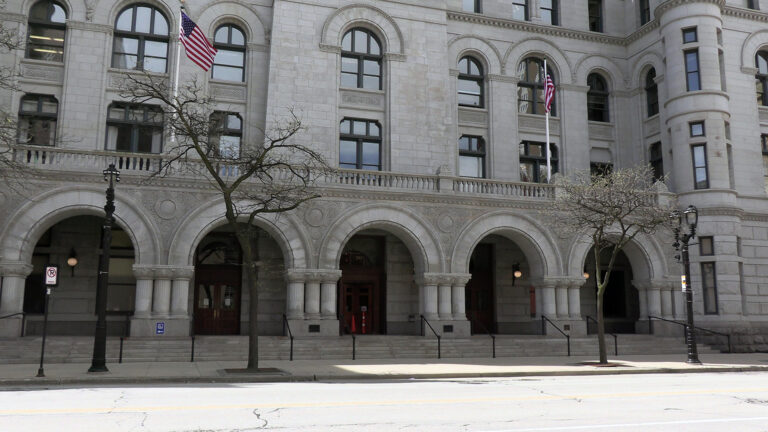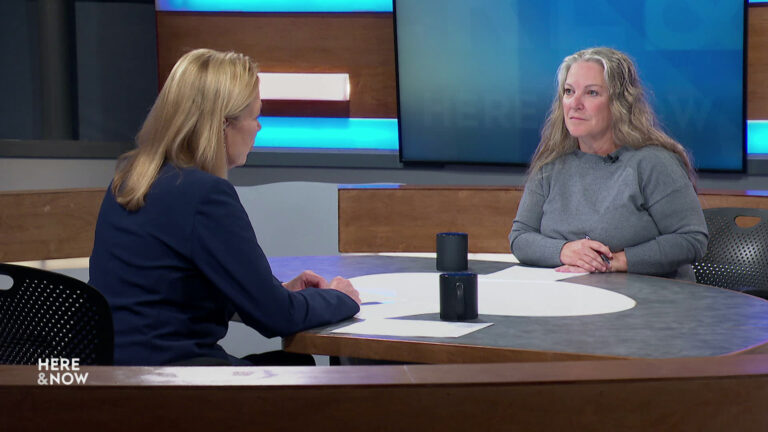Here & Now' Highlights: County Exec. David Crowley, Philip Mulder, Caroline Gomez-Tom
Here's what guests on the Aug. 15, 2025 episode said about recovery from flooding Milwaukee, misconceptions about flood insurance and rising Health Insurance Marketplace premiums.
By Frederica Freyberg | Here & Now
August 18, 2025

Frederica Freyberg and Milwaukee County Exec. David Crowley (Credit: PBS Wisconsin)
Milwaukee County awaits word whether federal assistance will help with recovery after torrential rains caused historic flooding, with County Exec. David Crowley saying early estimates put a dollar damage amount to public properties alone at more than $23 million. Wisconsin School of Business professor Philip Mulder offered information about who needs flood insurance amid the state’s low rates of coverage. Caroline Gomez-Tom, an enrollment manager with Covering Wisconsin, described why premiums for Health Insurance Marketplace plans are projected to see steep price increases in 2026.
County Exec. David Crowley
County Executive, Milwaukee County
- The flooding in Milwaukee that followed torrential rains on the night of Aug. 9 and into the early morning hours of Aug. 10 resulted in what’s been described as a 1,000-year flood. Crowley is asking residents whose homes and properties were damaged to report it to the 211 hotline.
- Crowley: “So far we’ve had the opportunity to actually assess over 2,900 different levels of properties. We see a lot more properties who have either major damage or completely destroyed. And so, we know that when it comes down to our public infrastructure, it exceeds $23 million today at this moment. As we continue to do these damage assessments, we’re just asking for the public’s patience to contact 211 as much as possible to report that damage so we can give an accurate assessment.
- Crowley said he hopes federal assistance will be forthcoming.
- Crowley: “You know, this is something that we never really understood was coming our way. But when you see what has happened in Greenfield, what has happened in West Allis, city of Milwaukee, including Wauwatosa, there’s a lot of damage. We’ve also heard about other communities outside of Milwaukee County who’ve also faced a certain level of damage. So, it is our hope that we will be able to receive some level of FEMA assistance compared to what we’ve seen out there with my own eyes — I do think that we’ve reached that threshold for a presidential declaration.”
Philip Mulder
Professor, Wisconsin School of Business Risk and Insurance Department
- According to the Office of the Commissioner of Insurance, Wisconsin has one of the lowest levels of flood insurance policies in the nation, with under 11,000 out of more than 2.7 million households holding them around the state. Mulder researches flood insurance costs and benefits and said many homeowners may not understand who needs the coverage — given the rising flood risks, should more people be covered?
- Mulder: “I think it’s a decision that every household has to make for itself. What I hope is that people can go in with full information. I think that often people assume that they have low risk because they’re not in a floodplain. That’s not always going to be true. People will say things like, ‘Oh, I can’t get flood insurance, I’m not in the floodplain.’ That’s not true. The National Flood Insurance Program will sell flood insurance in almost every community as a participating NFIP community. That means you can buy flood insurance inside or outside of the flood plain. So, people should understand their options. Now, there’s other steps you can take: sump pumps in your basement, elevating homes that are near waterways, keeping a buffer of savings. If you only face small, say, basement damages, these are other tools that homeowners can use to handle flood risk. But flood insurance is definitely one of those tools, and households should take a look at their budgets and see if that makes sense.”
Caroline Gomez-Tom
Enrollment network and accessibility manager, Covering Wisconsin
- Covering Wisconsin helps people sign up for Affordable Care Act plans through the Health Insurance Marketplace. Premiums for those plans are expected to increase sharply when people enroll in November for 2026. In Wisconsin, nearly 850,000 people are enrolled in ACA plans and insurers project premium increases ranging from 6.6% to 34.5%. Enhanced tax credits that allowed more people with higher incomes to enroll by offering subsidies for marketplace plans expire at the end of 2025. Gomez-Tom said she was taken aback by the projected premium hikes.
- Gomez-Tom: “It was definitely a startling hike, except we weren’t necessarily surprised knowing that there were some things that were in the mix regarding enhanced premium tax credits that were going away or potentially going away. You know, Congress could still act in these several months before the end of the year. And then some other policy changes that have happened at the federal level, plus, health care costs rising, inflation, et cetera, that could be a part of this. To see the numbers that we are expecting for this year took your breath away.”
Watch new episodes of Here & Now at 7:30 p.m. on Fridays.
 Passport
Passport











Follow Us